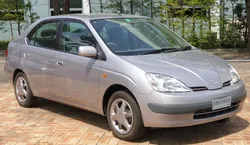

Toyota Prius - Generation 1 Facelift Review
Explore the Toyota Prius's Generation 1 Facelift (2000, XW10) features and specifications. Learn more about this innovative hybrid model in Portugal.
The Toyota Prius has become synonymous with hybrid technology since its launch. The first generation, known as the XW10, laid the foundation for what wo...
Technical Specifications
Select Version
Dimensions
Engine
Driving
Others
History and Features
Mycarro AI
Apr 27, 2025
Introduction to the Prius Generation 1
The Toyota Prius has become synonymous with hybrid technology since its launch. The first generation, known as the XW10, laid the foundation for what would become a revolutionary shift in the automotive industry. Released in the late 1990s, the Prius was Toyota’s answer to the increasing demand for fuel-efficient vehicles. With its unique design and innovative hybrid technology, the XW10 marked the beginning of a new era in transportation.
Facelift of the XW10
In 2000, Toyota introduced a facelift version of the original Prius, enhancing its aesthetics and technological features. The facelift was not just a cosmetic update; it involved significant improvements to the car's performance and fuel efficiency. The redesigned front and rear fascias, new headlamps, and rear light clusters offered a fresher and more modern appearance. Additionally, the facelift included improved aerodynamics, which contributed to a reduced drag coefficient—a key factor in enhancing fuel efficiency.
Hybrid Technology and Performance
The first-generation Toyota Prius, including the facelift version, was powered by a hybrid system that combined a 1.5-liter gasoline engine with an electric motor. This combination allowed the car to achieve impressive fuel efficiency, making it an attractive option for environmentally conscious consumers. The Prius was capable of achieving up to 41 miles per gallon (mpg) in the city and 51 mpg on the highway, setting new standards for fuel economy during its time.
The hybrid system utilized a nickel-metal hydride (NiMH) battery, which was groundbreaking in the 2000s. This technology not only enabled the vehicle to switch seamlessly between the gasoline engine and electric motor but also allowed for regenerative braking—a system that harvested energy typically lost during braking and converted it back into electrical energy to recharge the battery.
Interior and Comfort Features
Inside, the Prius Generation 1 (facelift 2000) offered a spacious cabin designed with comfort and functionality in mind. The dashboard displayed vital information, including fuel economy statistics and battery status, helping drivers keep track of their driving habits. The center console featured a modern design with user-friendly controls for climate and audio systems.
Seating in the Prius was relatively comfortable, with ample legroom and headroom for both front and rear passengers. For families and individuals who required versatility, the rear seats could fold down to provide additional cargo space, making it a practical choice for various lifestyles.
Safety Innovations
The XW10 facelift also saw Toyota place strong emphasis on safety. The Prius was equipped with features such as anti-lock brakes (ABS), traction control, and dual front airbags. It achieved commendable safety ratings during testing, reinforcing customer confidence in the vehicle. By providing these advanced safety features, Toyota demonstrated its commitment to driver and passenger safety, further enhancing the appeal of the Prius in the competitive automotive market.
Legacy and Impact
The impact of the first-generation Toyota Prius is undeniable. It was one of the first mass-produced hybrid vehicles and set the stage for nearly two decades of subsequent models that followed. The XW10 not only established Toyota as a leader in hybrid technology but also influenced automotive manufacturers worldwide to explore more sustainable options. Today, the Prius represents an essential chapter in the evolution of eco-friendly vehicles and continues to inspire innovations within the automotive sector.
Conclusion
The Toyota Prius Generation 1 (facelift 2000) (XW10) stands as a testament to innovation and foresight in the automobile industry. With its unique blend of hybrid technology, striking design, and focus on efficiency, the Prius reshaped consumer expectations for cars. As the world continues to shift towards sustainable alternatives, the Prius remains a trailblazer—an emblem of what can be achieved when technology and environmental awareness come together.
